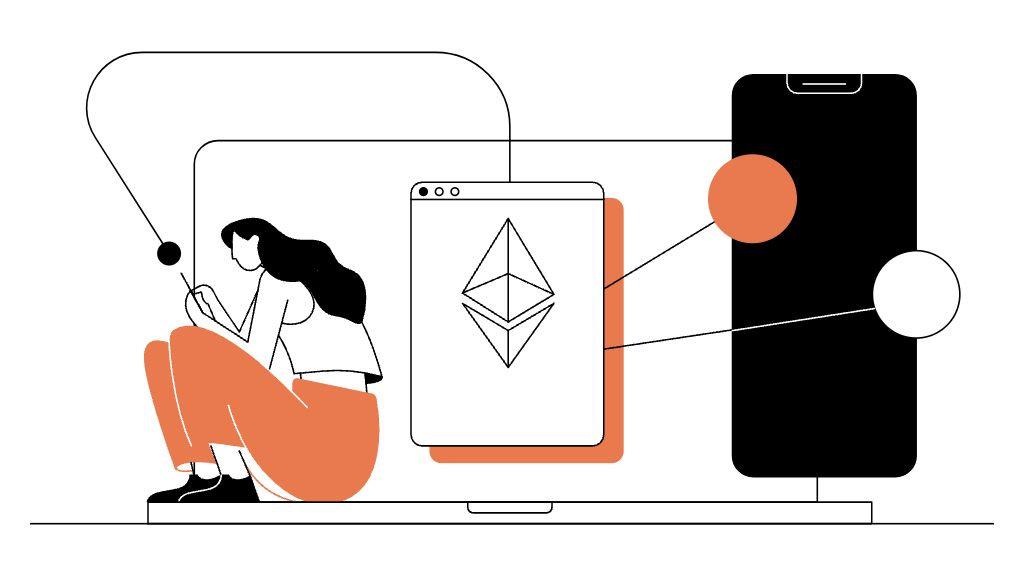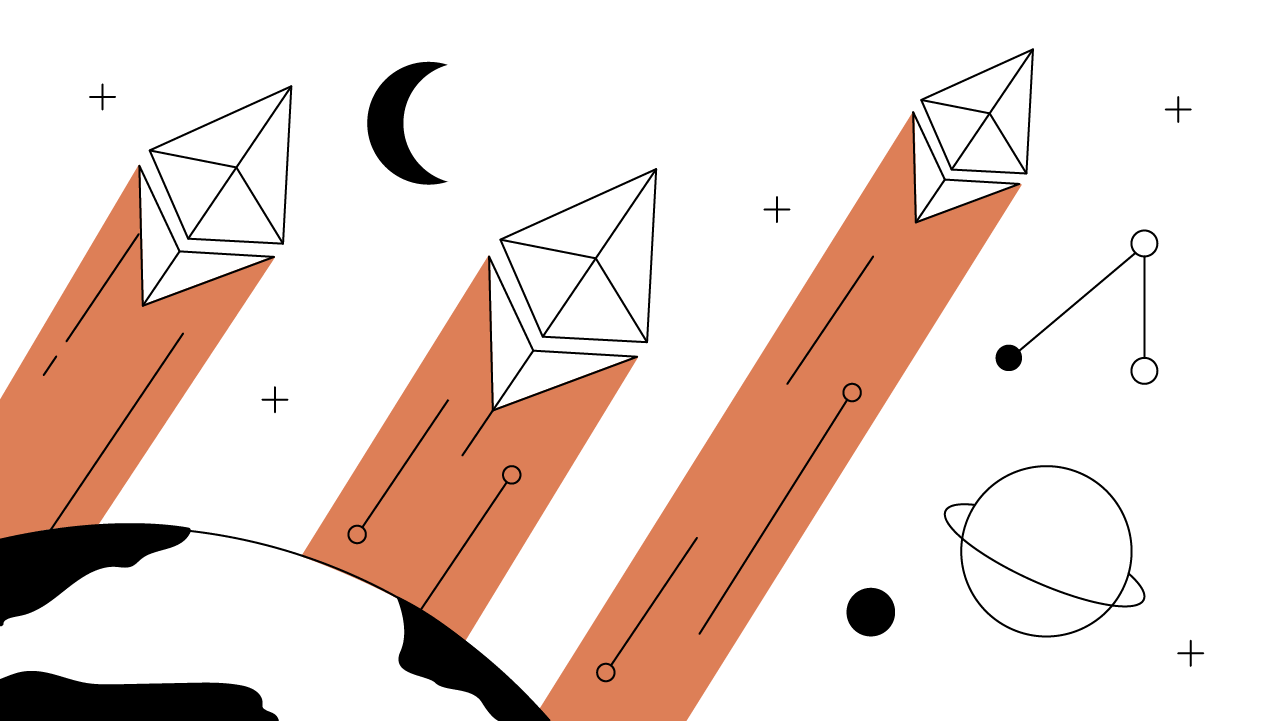Contents
Why Are Most dApps Built on Ethereum?
Ethereum offers exceptional tools that most dApps developers simply can’t ignore — we explore them here.
Updated November 16, 2023 • 4 min read

Summary
Despite the growth of alternative blockchain networks, decentralized applications (dApps) exist almost exclusively on the Ethereum blockchain. The Ethereum Virtual Machine (EVM) is the primary driver of this trend, with development kits and application templates serving to continuously improve the developer experience. In combination, these tools enable the development of any application that lacks its own platform. Projects can leapfrog the development of a proprietary blockchain by using the Ethereum framework. Decentralized apps on the Ethereum blockchain also benefit from a vast community of developers, amplifying the network effect. Decentralized apps using Ethereum also have a clear path to monetization, which also attracts developers. However, blockchains like EOS and TRON have shown that alternatives to Ethereum are gaining popularity within specific dApp market segments.
Decentralized applications (dApps) are built on blockchain networks and use smart contracts to create platforms that streamline and democratize the entry into industries ranging from finance to gaming — all without intermediaries and centralized authorities. In terms of front-end user experience, dApps appear nearly identical to traditional web applications. However, on the back-end, dApps function much differently than their conventional counterparts. Instead of employing the HTTP protocol to communicate with the broader network, dApps connect to the blockchain in a decentralized manner rather than routing through centralized servers.
Beyond token launches, retail dApps, and industry-specific applications, decentralized finance (DeFi) platforms have become the primary driver of dApp market value growth in 2020. But why exactly does Ethereum dominate dApp development, and is there room for diversification? A review of the Ethereum development ecosystem can help answer these questions.
Why Ethereum for dApps?
The Ethereum network currently dominates dApp development for several reasons. Ethereum implements a development interface that reduces programming time and helps quickly launch projects. Beyond this, the Ethereum developer community has grown remarkably since the platform’s launch. And Ethereum retains formidable network effects from its global coalition of technologists who remain committed to maintaining the network and actively developing user resources that drive adoption. Further, the ability to adequately monetize dApp projects incentivizes others to partake in the Ethereum ecosystem.
The Ethereum Virtual Machine (EVM)
Ethereum is known for providing a distinct and accommodating developer experience that makes it easier for novice blockchain developers to enter the space. A prime example of this is the Ethereum Virtual Machine (EVM), a unique software system that allows developers to launch any dApp regardless of the underlying coding language. Ethereum also uses a network-native language known as Solidity for coding smart contracts. This network architecture eliminates the need to develop an entirely new blockchain for every dApp.
Developers can work with the ready-made Ethereum system to fast-track onboarding and get their applications up and running sooner than other alternatives. This dynamic continues to drive the rapid development of DeFi products on the Ethereum network. By combining application templates, MetaMask integration, and the EVM, the overall Ethereum development kit allows companies to focus on refining their applications and developing on top of open-source code among a global, mission-based developer community that prioritizes cooperation over competition.
Developer Community and Network
Since launching in 2015, Ethereum has moved quickly from first mover to legacy status in the decentralized blockchain ecosystem. The network benefits from a highly skilled community of developers who have since built out crucial extension documentation and network updates to help the broader community. For example, Microsoft's Blockchain Development Kit for Ethereum and Diligence's Solidity Visual Auditor extension for Visual Studio code are used to enhance development on the Ethereum network. The increasing number of developers utilizing these solutions has perpetuated the development of better tools, better code, better platforms, and ultimately, better dApps.
Further, dApps like MakerDAO, IDEX, Bancor, and even CryptoKitties serve to amplify this network effect, drawing even greater attention to the Ethereum ecosystem. The function of composability, exemplified by dApps using open source code from other projects and building out token interoperability between platforms, has reinforced the cooperative infrastructure of the network. As a result, Ethereum has become the infrastructure of choice in every single dApp market segment.
Monetizing Ethereum dApps
Many dApps utilize a native token that facilitates activity within the application — also known as a utility token. On the Ethereum network, these tokens adhere to the ERC-20 tokenization standard, a set of rules that ensure Ethereum-based tokens can interact seamlessly with one another. This component of network architecture is critical to ensuring the continuity of Ethereum-based applications. To generate revenue, dApps can monetize their assets on existing crypto exchanges or launch their own decentralized exchange (DEX).
The ERC-20 standard enables the frictionless exchange of these crypto assets. Further, the increase in trading volume brings more awareness to dApps residing within the Ethereum ecosystem; the network reinvests in itself. A clear path toward monetization results from Ethereum's vast community and robust, interoperable network infrastructure.
Alternative dApp Networks
Although the Ethereum blockchain continues to dominate the dApp landscape, alternative networks are beginning to chip away at its market share. The dApp development and transaction volumes on EOS, TRON, IOST, Ontology, and NEO all point to the gradual diversification of the dApp ecosystem.
EOS: The EOS blockchain emphasizes its enterprise-grade use cases for public and private sector deployment. Nonetheless, the most popular dApps on the EOS network fall within the gaming and marketplace categories.
TRON: A recent network protocol update and a growing overall DeFi market are responsible for TRON’s rapidly expanding dApp market share.
NEO: The NEO blockchain asserts itself as the most developer-friendly platform. The network offers a comprehensive suite of developer tools that aim to build a future smart economy.
IOST: Notably, the IOST blockchain uses a new consensus algorithm known as "Proof of Believability" (PoB). In contrast to previous iterations, this mechanism considers factors such as reputation, participation, and behavior to improve network scalability and speed.
Ontology: The Ontology blockchain network specializes in digital identity and data. The network offers cross-chain interoperability and secondary blockchain layer solutions to improve scalability.
Diversifying the Ethereum dApp Ecosystem
In combination with development kits, application templates, and MetaMask integration, the EVM establishes Ethereum as the industry’s dominant dApp-construction framework. Together, these tools provide a developer-friendly experience that has proven effective in attracting new projects and large communities. The resulting network effect accelerates the monetization of products as real people interact with dApps in a meaningful way. This dynamic ensures projects can develop and implement a viable business model critical to long-term viability.
Despite the popularity of Ethereum dApps among developers, some opt for alternative blockchains that offer better scalability and throughput. Networks like EOS and TRON currently present the most significant disruption to Ethereum's dominance, despite the majority of network activity originating from gambling and other high-risk categories. Most notably, alternative dApp frameworks have an opportunity to leverage the rapid growth of DeFi, with many already benefiting from this trend.
Cryptopedia does not guarantee the reliability of the Site content and shall not be held liable for any errors, omissions, or inaccuracies. The opinions and views expressed in any Cryptopedia article are solely those of the author(s) and do not reflect the opinions of Gemini or its management. The information provided on the Site is for informational purposes only, and it does not constitute an endorsement of any of the products and services discussed or investment, financial, or trading advice. A qualified professional should be consulted prior to making financial decisions. Please visit our Cryptopedia Site Policy to learn more.

Is this article helpful?


